
Issue Archive
2011
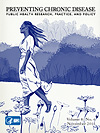
November
Volume 8: No.6
Conducting Community Audits to Evaluate Community Resources for Healthful Lifestyle Behaviors: An Illustration From Rural Eastern North Carolina; From Evidence-Based Medicine to Evidence-Based Health: the Example of Asthma; Feasibility of an Evidence-Based Weight Loss Intervention for a Faith-Based, Rural, African American Population.
Volume 8: No.6
Conducting Community Audits to Evaluate Community Resources for Healthful Lifestyle Behaviors: An Illustration From Rural Eastern North Carolina; From Evidence-Based Medicine to Evidence-Based Health: the Example of Asthma; Feasibility of an Evidence-Based Weight Loss Intervention for a Faith-Based, Rural, African American Population.
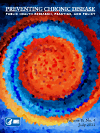
July
Volume 8: No.4
The role of state health departments in supporting community-based obesity prevention; Effect of school district policy change on consumption of sugar-sweetened beverages among high school students, Boston, Massachusetts, 2004-2006; Risks to health among American Indian/Alaska Native high school students in the United States.
Volume 8: No.4
The role of state health departments in supporting community-based obesity prevention; Effect of school district policy change on consumption of sugar-sweetened beverages among high school students, Boston, Massachusetts, 2004-2006; Risks to health among American Indian/Alaska Native high school students in the United States.
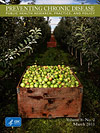
March
Volume 8: No.2
Preventing Chronic Disease: moving forward in 2011; Features and initial assessment of the Italian Behavioral Risk Factor Surveillance System (PASSI), 2007-2008; Moving multiunit housing providers toward adoption of smoke-free policies.
Volume 8: No.2
Preventing Chronic Disease: moving forward in 2011; Features and initial assessment of the Italian Behavioral Risk Factor Surveillance System (PASSI), 2007-2008; Moving multiunit housing providers toward adoption of smoke-free policies.
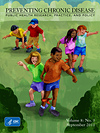
September
Volume 8: No.5
State requirements and recommendations for school-based screenings for body mass index or body composition, 2010; Using a concept map as a tool for strategic planning: The Healthy Brain Initiative; A midpoint process evaluation of the Los Angeles Basin Racial and Ethnic Approaches to Community Health Across the US (REACH US) Disparities Center, 2007-2009.
Volume 8: No.5
State requirements and recommendations for school-based screenings for body mass index or body composition, 2010; Using a concept map as a tool for strategic planning: The Healthy Brain Initiative; A midpoint process evaluation of the Los Angeles Basin Racial and Ethnic Approaches to Community Health Across the US (REACH US) Disparities Center, 2007-2009.
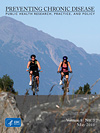
May
Volume 8: No.3
Effect of variable energy served on 24-hour energy intake in 16 preschools, Chicago, Illinois, 2007; Physical activity, watching television, and the risk of obesity in students, Texas, 2004-2005; Adolescent girls’ weight-related family environments, Minnesota.
Volume 8: No.3
Effect of variable energy served on 24-hour energy intake in 16 preschools, Chicago, Illinois, 2007; Physical activity, watching television, and the risk of obesity in students, Texas, 2004-2005; Adolescent girls’ weight-related family environments, Minnesota.
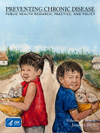
January
Volume 8: No.1
Preventing Chronic Disease: moving forward in 2011; Features and initial assessment of the Italian Behavioral Risk Factor Surveillance System (PASSI), 2007-2008; Moving multiunit housing providers toward adoption of smoke-free policies. Learn more about this cover.
Volume 8: No.1
Preventing Chronic Disease: moving forward in 2011; Features and initial assessment of the Italian Behavioral Risk Factor Surveillance System (PASSI), 2007-2008; Moving multiunit housing providers toward adoption of smoke-free policies. Learn more about this cover.
2010

November
Volume 7: No.6
Focusing on solid partnerships across multiple sectors for population health improvement; Quality of systematic reviews of observational nontherapeutic studies; Making room for mental health in the medical home; Special focus on Mobilizing Action Toward Community Health (MATCH). Learn more about this cover.
Volume 7: No.6
Focusing on solid partnerships across multiple sectors for population health improvement; Quality of systematic reviews of observational nontherapeutic studies; Making room for mental health in the medical home; Special focus on Mobilizing Action Toward Community Health (MATCH). Learn more about this cover.
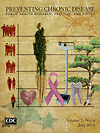
July
Volume 7: No.4
Mobilizing Action Toward Community Health (MATCH): metrics, incentives, and partnerships for population health (Includes interview podcast), Using metrics to improve population health The potential of black radio to disseminate health messages and reduce disparities. Special focus on MATCH. Learn more about this cover.
Volume 7: No.4
Mobilizing Action Toward Community Health (MATCH): metrics, incentives, and partnerships for population health (Includes interview podcast), Using metrics to improve population health The potential of black radio to disseminate health messages and reduce disparities. Special focus on MATCH. Learn more about this cover.
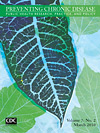
March
Volume 7: No.2
New in PCD: Post your comment through our online forum at PCD Dialogue, Designing competencies for chronic disease practice, The GirlStars program: challenges to recruitment and retention in a physical activity and health education program for adolescent girls living in public housing. Special focus on health communications. Learn more about this cover.
Volume 7: No.2
New in PCD: Post your comment through our online forum at PCD Dialogue, Designing competencies for chronic disease practice, The GirlStars program: challenges to recruitment and retention in a physical activity and health education program for adolescent girls living in public housing. Special focus on health communications. Learn more about this cover.
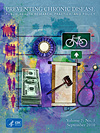
September
Volume 7: No.5
Can incentives improve population health? An interview with Bridget Booske, PhD (podcast); Cost-effectiveness analysis of efforts to reduce risk of type 2 diabetes and cardiovascular disease in southwestern Pennsylvania, 2005-2007; Achieving a high response rate with a health care provider survey, Washington State, 2006. Special focus on Mobilizing Action Toward Community Health (MATCH).Learn more about this cover.
Volume 7: No.5
Can incentives improve population health? An interview with Bridget Booske, PhD (podcast); Cost-effectiveness analysis of efforts to reduce risk of type 2 diabetes and cardiovascular disease in southwestern Pennsylvania, 2005-2007; Achieving a high response rate with a health care provider survey, Washington State, 2006. Special focus on Mobilizing Action Toward Community Health (MATCH).Learn more about this cover.

May
Volume 7: No.3
New in PCD: Post your comment through our online forum at PCD Dialogue, Institutional policy changes aimed at addressing obesity among mental health clients, Strategies for and barriers to managing weight when eating at restaurants. Special focus on the components of health and well-being. Learn more about this cover.
Volume 7: No.3
New in PCD: Post your comment through our online forum at PCD Dialogue, Institutional policy changes aimed at addressing obesity among mental health clients, Strategies for and barriers to managing weight when eating at restaurants. Special focus on the components of health and well-being. Learn more about this cover.
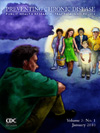
January
Volume 7: No.1
Editor in Chief Sam Posner on implementing the vision and moving forward at PCD, Worksite health promotion: principles, resources, and challenges, Chloropleth map design for cancer incidence, PCD thanks this year’s reviewers. Special focus on mental health. Learn more about this cover.
Volume 7: No.1
Editor in Chief Sam Posner on implementing the vision and moving forward at PCD, Worksite health promotion: principles, resources, and challenges, Chloropleth map design for cancer incidence, PCD thanks this year’s reviewers. Special focus on mental health. Learn more about this cover.
2009
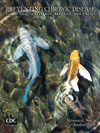
October
Volume 6: No. 4
Jim Marks on epidemiology, public health, and public policy, Disentangling the risks associated with weight status, diet, and physical activity, Monitoring prehospital stroke care in Utah to assess the feasibility of using EMS data for surveillance. Special focus on comprehensive cancer control. Learn more about this cover.
Volume 6: No. 4
Jim Marks on epidemiology, public health, and public policy, Disentangling the risks associated with weight status, diet, and physical activity, Monitoring prehospital stroke care in Utah to assess the feasibility of using EMS data for surveillance. Special focus on comprehensive cancer control. Learn more about this cover.
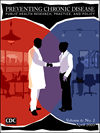
April
Volume 6: No.2
Interviews with Gene Matthews and Michael Eriksen, AARP and private-sector collaboration, Development of a community-wide cardiovascular risk reduction assessment tool for small rural employers in upstate New York. Special focus on public-private partnerships. Learn more about this cover.
Volume 6: No.2
Interviews with Gene Matthews and Michael Eriksen, AARP and private-sector collaboration, Development of a community-wide cardiovascular risk reduction assessment tool for small rural employers in upstate New York. Special focus on public-private partnerships. Learn more about this cover.
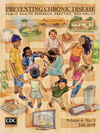
July
Volume 6: No. 3
Chronic disease prevention and control: coming of age at CDC, Design and dissemination of the MOVE! weight-management program for veterans, A socioeconomic analysis of obesity and diabetes. Special focus on childhood obesity. Learn more about this cover
Volume 6: No. 3
Chronic disease prevention and control: coming of age at CDC, Design and dissemination of the MOVE! weight-management program for veterans, A socioeconomic analysis of obesity and diabetes. Special focus on childhood obesity. Learn more about this cover
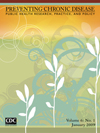
January
Volume 6: No.1
Child care as an untapped setting for obesity prevention, A promotora de salud model for addressing cardiovascular disease risk factors in the US-Mexico border region, Workplace health promotion in Washington State. Special focus on tools for public health practice. Learn more about this cover.
Volume 6: No.1
Child care as an untapped setting for obesity prevention, A promotora de salud model for addressing cardiovascular disease risk factors in the US-Mexico border region, Workplace health promotion in Washington State. Special focus on tools for public health practice. Learn more about this cover.
2008

October
Volume 5: No. 4
Lessons Learned From a Binational Survey to Examine Women’s Health Status in the US-Mexico Border Region, Reproductive Health Surveillance in the US-Mexico Border Region, Improving Ways to Generate and Use Local Data to Create and Strengthen Binational Programs. Learn more about this cover.
Volume 5: No. 4
Lessons Learned From a Binational Survey to Examine Women’s Health Status in the US-Mexico Border Region, Reproductive Health Surveillance in the US-Mexico Border Region, Improving Ways to Generate and Use Local Data to Create and Strengthen Binational Programs. Learn more about this cover.

April
Volume 5: No.2
Minnesota emergency response for acute stroke, Cancer control planning in the South Puget Intertribal Planning Agency, Tools for developing, implementing, and evaluating state policy. Special focus on heart disease and stroke prevention. Learn more about this cover.
Volume 5: No.2
Minnesota emergency response for acute stroke, Cancer control planning in the South Puget Intertribal Planning Agency, Tools for developing, implementing, and evaluating state policy. Special focus on heart disease and stroke prevention. Learn more about this cover.
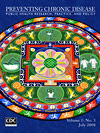
July
Volume 5: No. 3
Peer groupings in county health data, Stress and diabetes in American Samoa, Safe school routes and community benefits. Special focus on healthy behaviors. Learn more about this cover.
Volume 5: No. 3
Peer groupings in county health data, Stress and diabetes in American Samoa, Safe school routes and community benefits. Special focus on healthy behaviors. Learn more about this cover.

January
Volume 5: No.1
End of life preparation, Disaster preparedness and older adults, Clinical preventive services through community collaboration. Special focus on the health of older adults. Learn more about this cover.
Volume 5: No.1
End of life preparation, Disaster preparedness and older adults, Clinical preventive services through community collaboration. Special focus on the health of older adults. Learn more about this cover.
2007
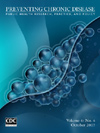
October
Volume 4: No. 4
Obesity research in African American communities, Topography of poverty, Strategies for physical activity among special populations. Special focus on the social determinants of health. Learn more about this cover.
Volume 4: No. 4
Obesity research in African American communities, Topography of poverty, Strategies for physical activity among special populations. Special focus on the social determinants of health. Learn more about this cover.
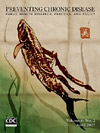
April
Volume 4: No.2
Filipino child health, Integration of chronic disease programs, Book review: What to Eat. Special focus on global health. Learn more about this cover.
Volume 4: No.2
Filipino child health, Integration of chronic disease programs, Book review: What to Eat. Special focus on global health. Learn more about this cover.
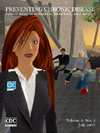
July
Volume 4: No. 3
Virtual community health promotion, Poverty and health in rural Mississippi, Lay health advisors and chronic kidney disease. Special focus on community wellness. Learn more about this cover.
Volume 4: No. 3
Virtual community health promotion, Poverty and health in rural Mississippi, Lay health advisors and chronic kidney disease. Special focus on community wellness. Learn more about this cover.
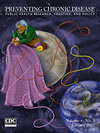
January
Volume 4: No.1
Population attributable fraction, State diabetes prevention and control, The Healthy Diabetes Plate. Special focus on the Coordinating Center for Health Promotion at the Centers for Disease Prevention and Control. Learn more about this cover.
Volume 4: No.1
Population attributable fraction, State diabetes prevention and control, The Healthy Diabetes Plate. Special focus on the Coordinating Center for Health Promotion at the Centers for Disease Prevention and Control. Learn more about this cover.
2006
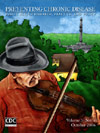
October
Volume 3: No. 4
Worksite program for parents of teens, Tooth loss after smoking cessation, Great Lakes regional stroke network. Special focus on Appalachian health. Learn more about this cover.
Volume 3: No. 4
Worksite program for parents of teens, Tooth loss after smoking cessation, Great Lakes regional stroke network. Special focus on Appalachian health. Learn more about this cover.
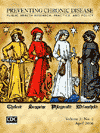
April
Volume 3: No.2
The Carter Center Mental Health Program, Chronic kidney disease, Logic model for mental health and chronic disease prevention, Chronic disease in health emergencies, Cancer coalitions in rural Appalachia, Adult television-viewing characteristics. Special focus on mental health. Learn more about this cover.
Volume 3: No.2
The Carter Center Mental Health Program, Chronic kidney disease, Logic model for mental health and chronic disease prevention, Chronic disease in health emergencies, Cancer coalitions in rural Appalachia, Adult television-viewing characteristics. Special focus on mental health. Learn more about this cover.
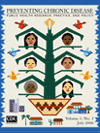
July
Volume 3: No. 3
Community Voices: Cherokee Choices, Community Voices: Wellness Village, Community Voices: Change for Life/Cambia tu vida, Community Voices: Videos on community health. Special focus on community health. Learn more about this cover.
Volume 3: No. 3
Community Voices: Cherokee Choices, Community Voices: Wellness Village, Community Voices: Change for Life/Cambia tu vida, Community Voices: Videos on community health. Special focus on community health. Learn more about this cover.
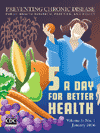
January
Volume 3: No.1
Role of race, ethnicity, and linguistic isolation in survey participation; Barriers to diabetes self-management education in rural Arkansas; Monitoring nutrition and physical activity programs. Special focus on program evaluation. Learn more about this cover.
Volume 3: No.1
Role of race, ethnicity, and linguistic isolation in survey participation; Barriers to diabetes self-management education in rural Arkansas; Monitoring nutrition and physical activity programs. Special focus on program evaluation. Learn more about this cover.
2005
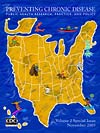
November
Volume 2: Special Issue
High school nutrition in Maine; Public health and Medicaid collaboration in Oregon; Geocoding and social marketing in Alabama. Special focus on health education. Learn more about this cover.
Volume 2: Special Issue
High school nutrition in Maine; Public health and Medicaid collaboration in Oregon; Geocoding and social marketing in Alabama. Special focus on health education. Learn more about this cover.
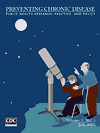
July
Volume 2: No. 3
Cancer screenings and vaccinations among older adults; Tracking healthy days among older adults; Chronic conditions among older Mexican American couples. Special focus on healthy aging. Learn more about this cover.
Volume 2: No. 3
Cancer screenings and vaccinations among older adults; Tracking healthy days among older adults; Chronic conditions among older Mexican American couples. Special focus on healthy aging. Learn more about this cover.
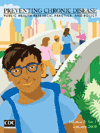
January
Volume 2: No.1
Diabetes outreach and education at the border; Community health coalitions; Effectiveness of a community-based program. Special focus on United States-Mexico border health. Learn more about this cover.
Volume 2: No.1
Diabetes outreach and education at the border; Community health coalitions; Effectiveness of a community-based program. Special focus on United States-Mexico border health. Learn more about this cover.

October
Volume 2: No. 4
Randomized trials and working-class samples; Diabetes assessment in American Indians; Walking for transportation in the United States. Special focus on health disparities. Learn more about this cover.
Volume 2: No. 4
Randomized trials and working-class samples; Diabetes assessment in American Indians; Walking for transportation in the United States. Special focus on health disparities. Learn more about this cover.
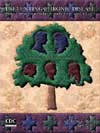
April
Volume 2: No.2
Public health workforce training; Chronic Disease Conference featured abstracts; Genomics content in state health programs. Special focus on genomics. Learn more about this cover.
Volume 2: No.2
Public health workforce training; Chronic Disease Conference featured abstracts; Genomics content in state health programs. Special focus on genomics. Learn more about this cover.
2004
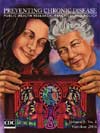
October
Volume 1: No. 4
Latinas and cervical cancer; Elders’ attitudes on physical activity; Complementary therapies and arthritis. Special focus on technology. Learn more about this cover.
Volume 1: No. 4
Latinas and cervical cancer; Elders’ attitudes on physical activity; Complementary therapies and arthritis. Special focus on technology. Learn more about this cover.
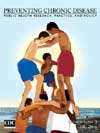
July
Volume 1: No. 3
VERB campaign and youth physical activity; Worksite heart attack awareness; Increasing fruit and vegetable consumption; Recruiting participants into a cancer trial. Learn more about this cover.
Volume 1: No. 3
VERB campaign and youth physical activity; Worksite heart attack awareness; Increasing fruit and vegetable consumption; Recruiting participants into a cancer trial. Learn more about this cover.
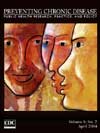
April
Volume 1: No.2
Part 2 of law in public health; Featured abstracts from the 2004 Chronic Disease Prevention Conference; Community model for skin cancer prevention; Pediatric hospitalizations for asthma. Learn more about this cover.
Volume 1: No.2
Part 2 of law in public health; Featured abstracts from the 2004 Chronic Disease Prevention Conference; Community model for skin cancer prevention; Pediatric hospitalizations for asthma. Learn more about this cover.
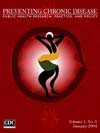
January
Volume 1: No.1
School health; Nutrition and homebound elders; Health interventions engaging communities of color; Part 1 of law in public health. Learn more about this cover.
Volume 1: No.1
School health; Nutrition and homebound elders; Health interventions engaging communities of color; Part 1 of law in public health. Learn more about this cover.
The opinions expressed by authors contributing to this journal do not necessarily reflect the opinions of the U.S. Department of Health and Human Services, the Public Health Service, the Centers for Disease Control and Prevention, or the authors’ affiliated institutions.

